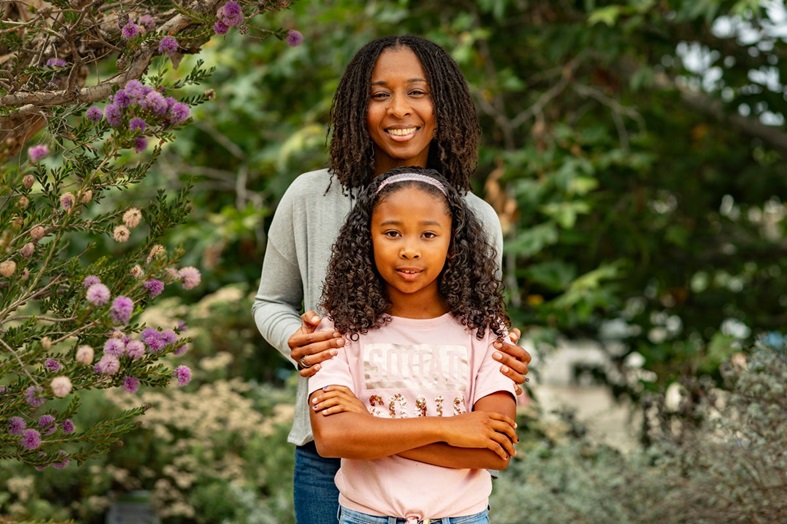Kimberly Narain and her daughter, now 10 years old, in Los Angeles in July 2023.
Helping Parents Talk to Children About Racism
When MSM alumna Kimberly Narain couldn’t find a book to help her talk to her daughter about the tumultuous events of 2020, she decided to write one.
By Giulia Cambieri, Harvard Public Health
How do you explain structural racism to children? Morehouse School of Medicine alumna Kimberly Narain wasn’t sure, but she was determined to try. The result was “The Cycle of a Dream: A Kid’s Introduction to Structural Racism in America.”
This self-published book looks at America’s history as a cycle in which new ways to deny Black people access to the American Dream continuously replace old ones. Slavery opened the door to segregation, mass incarceration, and the profound health and wealth disparities that exist today. Compared to predominantly White neighborhoods, Narain writes, “Most Black people still live in neighborhoods where there are fewer places to get help if you are sick, where there are fewer places to work, shop, or play, and where the schools get less money.”
In an interview with Harvard Public Health, Narain — a health systems researcher, physician, and assistant professor at the University of California, Los Angeles —
explains why she wrote the book, and how her education and her career path led her to this moment.
“I wrote ‘The Cycle of a Dream’ in 2020. It was a tumultuous year. Within a few weeks, Ahmaud Arbery, Breonna Taylor, and George Floyd were killed. Meanwhile, the pandemic was disproportionately affecting minority populations.
I was terrified that someone was going to say something to my daughter, who was seven, without my having the opportunity to contextualize it for her. I talk about the social determinants of health all the time but had no idea how to talk to her about them.
I looked at my personal library and everything felt incomplete. I discovered that developmental psychologists had been advocating for children to have more direct conversations about race to eliminate bias and promote a desire for social justice. I wanted my book to help parents have those conversations.
It was important to highlight the agency of Black people. I also wanted to trace the line between past policies and current outcomes — for example, how slavery connects to today’s wealth gap. And I wanted my daughter to know that people of all races worked to make progress. When the book came out, I received more support than I ever expected, including from non-Black parents who told me they wished they’d had it as children. I want kids to know that there’s nothing natural about racial hierarchies. We need to nurture empathy to create a more just society for everyone. And you can’t do better than to start with kids.
Looking back, many strands of my career led me to this moment.
When I went to college at the University of California, Los Angeles, I intended to focus on premed but began to understand the profound consequences that our broader social context has on our health. I ended up with a double major in microbiology and molecular genetics and African American studies—and a lifelong desire to deepen my understanding of both health care and these societal factors.
After graduating from Morehouse School of Medicine and completing my internal medicine residency at the University of California, San Francisco, I learned about the California Endowment Scholars in Health Policy at Harvard, which led me to Harvard Chan School in 2010 to pursue my MPH. From the mentorship of Joan Reede [a professor at Harvard Chan School and Harvard Medical School, where she is also dean for diversity and community partnership] to David Williams’s class on neighborhood segregation, to working with [Harvard Chan School instructor] Lindsay Rosenfeld on the health impacts of housing policies, it was a transformative year. And it shapes the way I approach my work.
What I learned during my MPH program gives me humility when I see patients. I don’t see myself as having better expertise. I see myself as having a different expertise. Patients are experts in their own social context, and we come up with the best outcomes when we work together.
Back at UCLA, I did a PhD in health services research, with a focus on public policy. I’m now an assistant professor at UCLA. Recently my work has focused on obesity-related diseases. For instance, I looked at the barriers Hispanic patients face to access diabetes treatments and highlighted interventions that hospital systems can implement to improve access.
I’m currently working to better integrate my research and the care I provide. Obesity is a huge problem for my patients, and I want to be better equipped to address it. That’s what guides my education. I ask myself, ‘How can I be more effective no matter what space I’m in?’”


